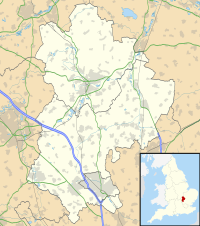Maiden Bower hillfort facts for kids
| Location | near Dunstable, Bedfordshire |
|---|---|
| Coordinates | 51°53′31″N 0°33′11″W / 51.89194°N 0.55306°W |
| Area | 4.9 hectares (12 acres) |
| History | |
| Periods | Neolithic Iron Age Romano-British |
| Site notes | |
| Excavation dates | 1913 |
| Archaeologists | Worthington G. Smith |
| Designated | 13 December 1929 |
| Reference no. | 1015593 |
Maiden Bower is an ancient hillfort located near Dunstable in Bedfordshire, England. It was built during the Iron Age, but people also lived there much earlier, in the Neolithic period. Today, it is a special protected place called a scheduled monument.
Contents
What is Maiden Bower?
Maiden Bower sits on a flat area of land, like a plateau. It's a large, round fort, about 225 meters wide. This covers an area of about 4.9 hectares, which is roughly the size of seven football fields!
The fort has a single protective wall, called a rampart, which is up to 3 meters high. Sadly, about 100 meters of this wall has been lost due to a nearby chalk quarry. There was also a ditch around the fort, but it's now filled in and can't be seen from above.
The Fort's Entrance
The original entrance to the fort is on the south-east side. In 1913, an archaeologist named Worthington George Smith and the site's owner dug there. They found what looked like the remains of a wooden gate.
Near the entrance, they discovered a large pit. Inside were the bones of about 50 people. Experts believe this was a special ritual burial, not a sign of a battle.
Life Before the Fort: The Neolithic Period
Before the Iron Age fort was built, people lived at Maiden Bower during the Neolithic period (the New Stone Age).
Worthington Smith explored areas outside the fort between the 1890s and 1915. He found parts of a segmented ditch. Inside this ditch, he discovered old flint tools and pottery. In the 1930s, it was confirmed that these finds were from the Neolithic period. This ditch was part of a causewayed enclosure, which was a type of early settlement. The later Iron Age hillfort was built partly over this older site.
Roman Times at Maiden Bower
Even after the Iron Age, people continued to visit or live near Maiden Bower during the Roman period. Before any digging happened, Roman coins and other objects were found in the area.
In 1907, Worthington Smith found a small Roman burial ground on the north-west side of the fort. Here, he discovered Roman pottery. Later, in 1991, more Roman pottery was found inside the fort. A special survey using ground-penetrating radar showed that there might have been a Roman building on the western side. Some think it could have been a Roman temple.
The Mystery of the Turf Maze
An old historian named William Stukeley thought that Maiden Bower might have once had a turf maze. These mazes were patterns cut into the ground, often used for games or rituals. He believed Maiden Bower was one of these sites, similar to other places called "Julian's Bowers."
Images for kids



